Advertisements
Advertisements
प्रश्न
Two capacitors of capacitance 20⋅0 pF and 50⋅0 pF are connected in series with a 6⋅00 V battery. Find (a) the potential difference across each capacitor and (b) the energy stored in each capacitor.
उत्तर
Given :
`C_1 = 20.0 "pF"`
`C_2 = 50.0 "pF"`
When the capacitors are connected in series, their equivalent capacitance is given by `C_(eq) = (C_1C_2)/(C_1+C_2)`
∴ Equivalent capacitance,`C_(eq) = ((50 xx 10^-12) xx (20 xx 10^-12))/((50 xx 10^-12)+(20 xx 10^-12))` = `1.428 xx 10^-11 "F"`
(a) The charge on both capacitors is equal as they are connected in series. It is given by
`q = C_(eq) xx V`
⇒ `q = (1.428 xx 10^-11) xx 6.0 "C"`
Now ,
`V_1 = q/C_1 = ((1.428 xx 10^-11) xx 6.0 "C")/((20 xx 10^-12))`
⇒ `V_1 = 4.29 "V"`
and
`V_2 = (6.00 - 4.29) V = 1.71 "V"`
(b) The energies in the capacitors are given by
`E_1 = q^2/(2C_1)`
= `[(1.428 xx 10^-11) xx 6.0]^2` `xx 1/(2 xx 20 xx 10^-12)`
= `184 "pJ"`
and
`E_2 = q^2/(2C_1)`
= `[(1.428 xx 10^-11) xx 6.0]^2` `xx 1/(2 xx 50 xx 10^-12)`
= `73.5 "pJ"`
APPEARS IN
संबंधित प्रश्न
The potential difference applied across a given resistor is altered so that the heat produced per second increases by a factor of 9. By what factor does the applied potential difference change?
In the figure shown, an ammeter A and a resistor of 4 Ω are connected to the terminals of the source. The emf of the source is 12 V having an internal resistance of 2 Ω. Calculate the voltmeter and ammeter readings.
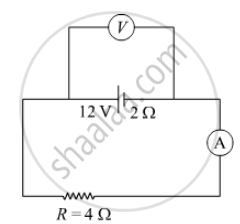
Draw a schematic diagram and explain the working of Van de Graff generator device.
Is there any restriction on the upper limit of the high voltage set up in Van de Graff generator machine? Explain.
A test charge ‘q’ is moved without acceleration from A to C along the path from A to B and then from B to C in electric field E as shown in the figure. (i) Calculate the potential difference between A and C. (ii) At which point (of the two) is the electric potential more and why?
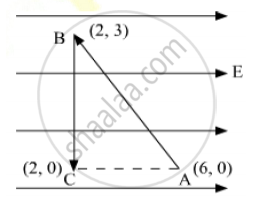
The figure shows a plot of three curves a, b, c, showing the variation of photocurrent vs collector plate potential for three different intensities I1, I2and I3 having frequencies v1, v2 and v3 respectively incident of a photosensitive surface.
Point out the two curves for which the incident radiations have same frequency but different intensities.
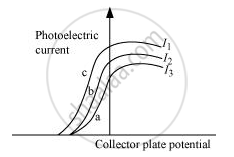
Both the capacitors shown in figure are made of square plates of edge a. The separations between the plates of the capacitors are d1 and d2 as shown in the figure. A potential difference V is applied between the points a and b. An electron is projected between the plates of the upper capacitor along the central line. With what minimum speed should the electron be projected so that it does not collide with any plate? Consider only the electric forces.
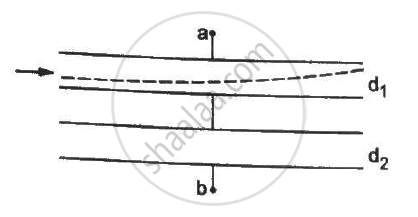
Find the potential difference between the points A and B and between the points B and C of the figure in steady state.

A charge of `+2.0 xx 10^-8 C` is placed on the positive plate and a charge of `-1.0 xx 10^-8 C` on the negative plate of a parallel-plate capacitor of capacitance `1.2 xx 10^-3 "uF"` . Calculate the potential difference developed between the plates.
A charge of 20 µC is placed on the positive plate of an isolated parallel-plate capacitor of capacitance 10 µF. Calculate the potential difference developed between the plates.
The capacitance between the adjacent plates shown in figure is 50 nF. A charge of 1⋅0 µC is placed on the middle plate. (a) What will be the charge on the outer surface of the upper plate? (b) Find the potential difference developed between the upper and the middle plates.
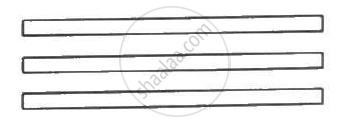
What will be the potential difference in the circuit when direct current is passed through the circuit?
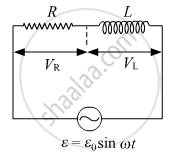
In circuits, a difference in potential from one point to another is often called ______.
Two metal pieces having a potential difference of 800 V are 0.02 m apart horizontally. A particle of mass 1.96 × 10–15 kg is suspended in equilibrium between the plates. If e is the elementary charge, then charge on the particle is ______.
A and B are two points in an electric field. If the work done in carrying 4.0C of electric charge from A to B is 16.0 J, the potential difference between A and B is:
An α-particle and a proton are accelerate at same potential difference from rest. What will be the ratio of their final velocity?
On moving a charge of 20 C by 2 cm, 2 j of work is done then the potential difference between the point is:-
Can there be a potential difference between two adjacent conductors carrying the same charge?
